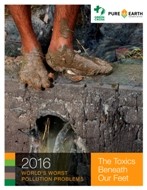About This Year’s Report
The 2016 World’s Worst Pollution Problems report is the 11th in an annual series published by Green Cross Switzerland and Pure Earth. Over the past decade, this series has identified and drawn attention to the worst, and most dangerously polluted places on the planet, while documenting and quantifying the startling health and environmental impacts of this neglected problem. The “World’s Worst” series of reports aim to raise global awareness about the extent and impacts of toxic pollution in low- and middle-income countries.
This year’s report, The World’s Worst Pollution Problems 2016: The Toxics Beneath Our Feet presents an update of the top ten polluting industries based on each source’s global burden of disease. The top ten industries are identified as used lead acid battery (ULAB) recycling, mining and ore processing, tanneries, dumpsites, industrial estates, smelting, artisanal small-scale gold mining (ASGM), product manufacturing, chemical manufacturing, and the dye industry. These industries collectively put over 32 million people at risk and account for 7 million to 17 million Disability-Adjusted Life Years (DALYs) in low- and middle-income countries.
Table 1. Worst Polluting Industries Ranked by DALYs
| Rank | Industry | DALYs |
| 1 | ULAB | 2,000,000 - 4,800,000 |
| 2 | Mining and Ore Processing | 450,000 - 2,600,000 |
| 3 | Lead Smelting | 1,000,000 - 2,500,000 |
| 4 | Tanneries | 1,200,000 - 2,000,000 |
| 5 | ASGM | 600,000 - 1,600,000 |
| 6 | Industrial Dumpsites | 370,000 - 1,200,000 |
| 7 | Industrial Estates | 370,000 - 1,200,000 |
| 8 | Chemical Manufacturing | 300,000 - 750,000 |
| 9 | Product Manufacturing | 400,000 - 700,000 |
| 10 | Dye Industry | 220,000 - 430,000 |
The number of toxic sites identified and recorded by Pure Earth, Green Cross and local collaborators has continued to increase and an extrapolation from this suggests that there are perhaps 150,000 sites in the approximately 50 countries where investigations are underway. The current estimate of the population at risk in low- and middle-income countries is about 200 million.
Large as these numbers are, they are almost certainly underestimates. As researchers and communities continue to identify and expose toxic hotspots and their surrounding populations, the numbers will likely increase. Similarly, though it is now accepted that pollution can lead to a broad range of acute effects as well as longer-term consequences, scientists are still trying to understand the true depth and mechanisms of these connections. In its most current figures, the World Health Organization reports that an estimated 23 percent of all deaths in 2012 (representing 12.6 million people) and 26 percent of deaths in children under age five were attributable to environmental risk factors, including pollution. Approximately one-fifth of the global cancer incidence is associated with environmental exposures. This number is disproportionately higher in developing countries.
As this knowledge grows, it is expected that deaths and disabilities that were previously linked to other risk factors will be more accurately attributed to pollution. However, much of the needed research is still in its nascent stages. There is only limited data on many of the complex biological and biochemical mechanisms behind the health impacts of toxic pollutants and this gap prevents researchers from truly grasping the scope of the health effects of pollution.
To expand on these efforts, The Global Commission on Pollution and Health has been convened by The Lancet medical journal, the Global Alliance on Health and Pollution and Mount Sinai Medical Center (New York). Its aim is to present critical data to key decision makers about pollution’s severe and under recognized contribution to the global burden of disease and its staggering economic costs. Significantly, until recently the lack of detailed information across a sufficient range of sites and conditions has precluded robust economic analysis of the costs of pollution. Developing and presenting key health and economic facts can help to motivate governments that have been slow to prioritize pollution control measures. The Commission is scheduled to present its report in early 2017.





